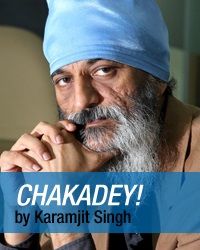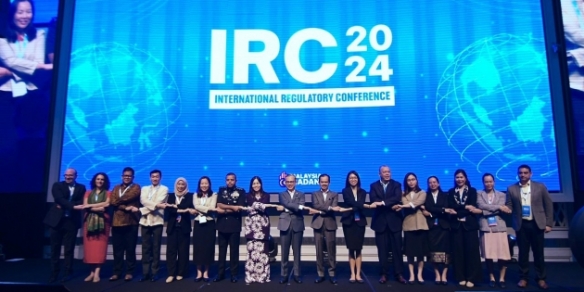Week in Review: There’s so much more to hackathons
By Karamjit Singh September 13, 2013
- Currently used to get people together to build apps in 24-hours
- But there is valuable information beyond the app that should be mined
 A VERY good journalist once told me that a good journalist has to be like a sponge.
A VERY good journalist once told me that a good journalist has to be like a sponge.
“You absorb some information in one conversation, add to that in another, and so on -- and sometimes something you observe, hear about or read about can then trigger the release of all that you have absorbed through an article,” he said.
This is exactly what I am doing now. I had a very interesting discussion this morning with the chief executive officer (CEO) of a listed company, with a market capitalisation in excess of RM500 million (US$153 million).
He launched his company offering system integration services in 2005, but about three years ago, saw the potential of big data and started pouring resources into building his own big data analytics solutions. He has that today and is already competing against the big boys and winning.
You will have to wait till mid-October for that story as he got a message from his chief financial officer during our chat reminding him that he is in the ‘quiet period’ where he can’t be quoted in the media talking about the company’s prospects.
So I had big data on my mind and the insights that analytics can bring to the mass of data many companies are struggling to make sense of. And of course, I had a chat with Bob Chua about the exciting stuff he is doing with Pulsate last week.
Over the weekend, I was also a judge at a hackathon organised by the Malaysian Communications and Multimedia Commission (MCMC) and AT&T, and that was equally exciting for me.
To be around 170, mainly youths, as they worked through an intense 24-hour period to build an app that would solve a problem was an eye-opener for me as I realised the value of these hackathons in getting people to think about solving real problems and in working in teams to build something useful.
My colleague A. Asohan also sees the value of these hackathons but felt that it was important that someone captures critical information from these events which would be valuable data for the government to identify trends and spot weaknesses too.
As soon as he said that, and with my conversations around the val;ue of data analysis, I had my ‘Aha!’ moment and the theme for this week’s column! We have got to capture all that data from the various hackathons organised so that we can spot trends and key information that arises from these gatherings of mainly technically literate young people.
While Multimedia Development Corporation (MDeC) does a great job of capturing such data from its own ICON programmes, no one is doing so for the various hackathons being run -- and that is a shame.
Among the data that can be collected are: What kind of technologies are popular in building apps, and why are others not popular? Are Malaysians using difficult technical tools in their app development? Why not? Are the opportunities they see well-thought through or just surface-level? Are the teams multiracial? Does that matter? Do coders come into hackathons with their teams already established or form their teams with strangers they meet there? Does this impact their chances of building strong apps?
And then, who are the ones who stick with their apps after the hackathons? Refining and improving them to actually try to wrap a business model around them? Do they know how to market them? Are non-technical people aware that they too play important roles in hackathons?
The list can go on. But it would be great if there was an effort made to start capturing all this data that is available from organising the various hackathons in town and not just in Kuala Lumpur. Penang recently had one too.
Capturing this data helps both the relevant government agencies and the organisers of hackathons to create stronger events with participants taking home more meaningful experiences and relationships formed. And with hackathons gaining in popularity, they are also starting to attract future entrepreneurs who hope to attract a techie to their team as co-founder or chief technical officer (CTO). I actually met two people at the MCMC hackathon who came for this.
Last year, one entrepreneur wanted to organise the biggest hackathon in South-East Asia but did not manage it. I wonder if anyone is planning anything along that scale now. If they do, I hope someone will start to dissect the event to capture all the key data so it can be used for future hackathons too.
Finally, congratulations to Ashran Ghazi and the Joota team for raising US$700,000 to add to the US$1.6 million they raised previously!
To wrap the week up, here’s the list of my picks for DNA’s top stories with 'Don’t be too in love with your idea' the most popular of the week.
Editor's Picks
DiGi’s Internet for All: From ad campaign to corporate mission
MCMC-AT&T hackathon scores with participants
Expanding intellectual horizons with CultureRun
Don't be too much in love with your idea
Joota secures US$700,000 in funding
Apple’s new iPhones continue to aim at high-margin sweet spot
Telenor – tomorrow’s Internet company
Previous Instalments:
Week in Review: We are hustling all the time
Week in Review: The pain they go through …
Week in Review: Is listing the end or the beginning?
Week in Review: It’s ALL about execution
Week in Review: What’s driving Syed Mokhtar’s telco interest?
For more technology news and the latest updates, follow @dnewsasia on Twitter or Like us on Facebook.


